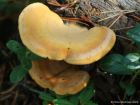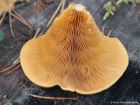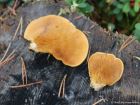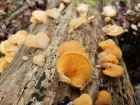Cap roughly fan-shaped or semicircular, with a convex shape and a dry texture. It is prominently hairy, especially when young, occasionally displaying a whitish dusting initially but quickly transitioning to bright orange, which fades to yellowish orange or orangish-yellow over time. When young, the margin is rolled inward. The flesh is pale orange, soft and not changing when sliced. Gills close or nearly crowded, thin with frequent short-gills. They range in colour from bright to pale orange. Stem very short or nonexistent. Spore print very pale pink.
Microscopic Features: Spores measure 4.5–6 x 1.5–2.5 µm and are allantoid, smooth, and hyaline in KOH, with no amyloid reaction.
Phyllotopsis nidulans on the MushroomExpert.Com Web site.
The fifth photo is by myco20200701 and licensed under the Creative Commons Attribution-ShareAlike 3.0 Unported license.
Many mushrooms are poisonous, and some can be lethally toxic. Distinguishing between edible and poisonous mushrooms can be very challenging. Therefore, we strongly advise against consuming wild mushrooms. This website does not contain any information about the edibility or toxicity of mushrooms.
Although efforts have been made to ensure accuracy on this website, the information may contain errors and omissions. Therefore, all content provided is for educational and informational purposes only and should not be relied upon or used as a basis for consuming any plants or mushrooms.
External links are provided for reference only. We do not endorse or take responsibility for the content, advice, or products found on these sites or in any advertisements shown on this website.




